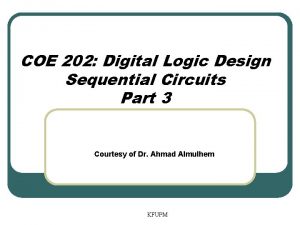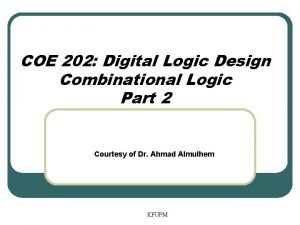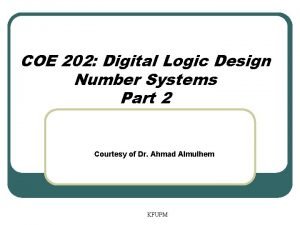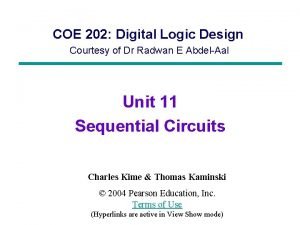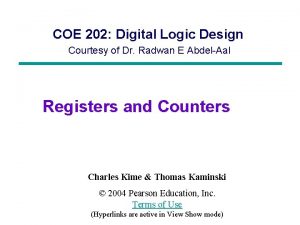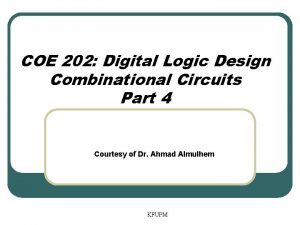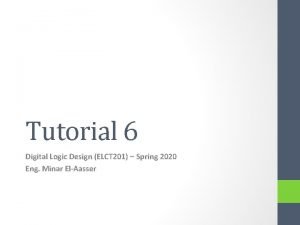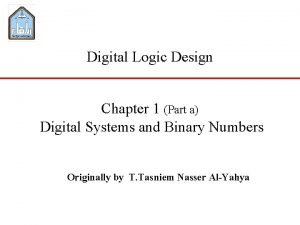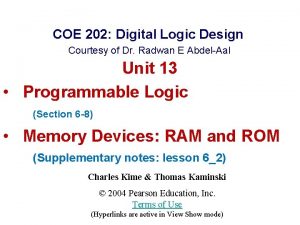COE 202 Digital Logic Design Courtesy of Dr




























- Slides: 28

COE 202: Digital Logic Design Courtesy of Dr. Radwan E Abdel-Aal Logic and Computer Design Fundamentals Chapter 3 and – Combinational Registers Counters Logic Design Part 1 – Implementation Technology and Logic Design Charles Kime & Thomas Kaminski © 2004 Pearson Education, Inc. Terms of Use (Hyperlinks are active in View Show mode)

Registers and Counters Useful MSI blocks made of Flip-Flops § § Registers with Parallel Load Shift Registers Counters: Synchronous and Asynchronous Modulo Counters Chapter 3 - Part 1 2

Registers § Register – a collection of binary storage elements § In theory, a register is sequential logic, i. e. can be defined by a state table § But more often, we think of a register as an array of n flip flops (possibly with some extra gates) that store a vector of n binary bits § Used to perform simple data storage, movement, manipulation and processing operations (e. g. load, increment, shift, add, etc. ) § The computer processes data by performing operations on registers, e. g. ADD A, B where A and B are say 32 -bit registers Chapter 3 - Part 1 3

Register/Counter Design Methods § Classical Direct Approach: From State Diagram Design individual cells using the state diagram/state table model and combine them into a register § Problem: for n large number of states state diagram/state table model is often not feasible!- Pentium has 64 -bit data registers (states = ? ) § Alternative (Ad hoc? ) Approach: (similar to iterative design method in combinational logic) Add predefined combinational circuits to a register to perform desired functions § Example: To count up, connect the register flip-flop outputs to an incrementer Chapter 3 - Part 1 4

Example: 4 -bit Register, with Clear & Selective Parallel Load by clock gating Q Reset (Cleared) Asynchronously with A 0 pulse on the normally High Clear input Loaded with Data at inputs at every clock edge D Q D 3 -D 0 Data to be loaded What is the problem with this? Clock input to FFs You need a controlled loading, only when input data is valid and a Load Signal arrives (not on every clock pulse!) Solution: Gate the clock to the Register flip flops so that clock Pulses arrive only when Load = 1 Chapter 3 - Part 1 5

Further Improvement Avoid clock gating. Apply Load control to D input Avoid clock gating if you can! It causes clock skew – clock arriving to various flip flops in the system at different times So such flip flops change state at different times No good- could lead to erroneous state transitions! EN = 1 for Load EN = 0 for no Load External Data to be loaded But we control what Clock pulses do using The EN control on D Clock pulses go Always Unhindered To all FFs Load does not gate the clock, D 3 -D 0 Data to be loaded But controls what goes into the D input Load = 1 EN = 1, D = input data to be loaded on next clock edge Load = 0 EN = 0, D = present Q, so no change on next clcok edge Chapter 3 - Part 1 6

Shift Registers § Shift Registers move data laterally ( ) within the n-bit register toward its MSB or LSB position § In the simplest case, the shift register is simply a set of D flip-flops connected in a row like this: Serial D Serial Shift Left Shift Right § Data input, In, is called a serial input or the shift right input. § Data output, Out, is often called the serial output (=D). § The vector (A, B, C, D) is called the parallel output. Chapter 3 - Part 1 7

Shift Registers § Behavior of the 4 - stage serial shift register Initial register state just before the first clock pulse arrives § T 1: State after the first pulse and before the second § Initially unknown states are denoted DQ DQ C DQ DQ Out Clock CP CP T 1 T 2 T 3 T 4 by “? ” § Complete the last three T 5 rows of the table B A In T 6 In 0 1 1 A ? 0 1 1 0 B ? ? 0 1 1 1 Problem: Serial loading takes n clock cycles. Possible Improvements: Load in parallel? 1. Serial I/P Appears in parallel In register C ? ? ? 0 1 D, Out ? After 4 ? Clock ? Pulses: ? 0 2. Serial I/P starts 1 appearing 1 Serially at O/P 0 Chapter 3 - Part 1 8

Some Shift Register Applications § Delaying: input sequence appears at output after n-clock cycles § Parallel to serial (and Serial to parallel) conversion Lateral Shift n Parallel Load n–bit Shift Register 101100000010110 Serial Link e. g. Ethernet n–bit Shift Register Parallel Read n § Arithmetic: Shifting one bit to the right causes dividing by ? Shifting one bit to the left (inserting 0 s) causes multiplying by ? Chapter 3 - Part 1 9

Shift Register with Parallel Load § ddd D input Selection hardware. Could use a MUX here! Parallel Input i = 0, 1, . . , 3 Qi Di Qi Serial Input Q 0 Q(i-1) Qi; i=1, …, 3 Serial Out Chapter 3 - Part 1 10

Parallel Data I/P 4 -to-1 MUX Info Inputs Mode Select Inputs Bi-directional Shift Register with Parallel Load Chapter 3 - Part 1 11

Counters § A counter is a register that has its parallel outputs "count" through a specific state sequence § Sequences can be binary, BCD, etc. § Counting can be up, down § A modulo-n counter goes through values 0, 1, 2, …, (n-1) e. g. modulo-10 up counter counts: 0, 1, … 9 ABC (LSB) Some Applications: § Frequency division § Event counting § Timers This is a modulo-? Up/Down? Counter Successive Clock Pulses 000 001 010 011 100 101 000 001 Chapter 3 - Part 1 12

Implementing Counters Two Basic Approaches § 1. Asynchronous (Ripple) Counters • The external clock is connected to the flipflop clock input of the LSB bit flip-flop (first counter stage) • For all subsequent stages, the clock input is derived from the output of the preceding stage, • i. e. circuit is not truly synchronousno common clock to all stages • Advantage: - Simpler circuit, lower power consumption • Disadvantages: - Output change delayed further for each stage toward the MSB - Max clock frequency limited by this ripple propagation delay Chapter 3 - Part 1 13

Ripple Up and down Counter Modulo-16 binary counter (n = 4) In-stage Toggling link Every Stage Toggles Up Down Inter-stage Clocking link Worst-case Ripple delay of 4 t. PHL Toggle at - ive edge on Q 0 Connect Q to next C fc/16 fc/8 fc/4 fc/2 fc = Clock Frequency Division How to get an Up/Down counter? Toggle at + ive edge on Q 0 Connect Q to next C 14

Ripple Up Counter 2 -bit counter (modulo 4: Counts: 00, 01, 10, 11 § How does it work? D • At the positive External CR edge on the external Clock, f Hz clock input Q (i-1) of A, A toggles D to Clk (i) • The clock input for flip. CR flop B is the Reset complemented output of flip-flop A CP • When flip A changes from 1 to 0, there is a QA 0 1 positive edge on the +ive QB clock input of B edges 0 0 1 1 On Q causing B to 0 1 2 3 complement it toggles LSB A f/2 Hz 2 Toggling stages- each is modulo-2 i. e. divide by 2 B f/4 Hz 00 01 10 11 0 Toggle Every CP 0 0 0 1 Toggle Every 2 CPs Chapter 3 - Part 1 15

Ripple Counter (continued) Ripple delay: may limit max clock frequency § These are called ripple counters because in order to toggle, each stage waits for a change in the output of the previous stage edge § Such changes “ripple” through the chain of flip-flops, i. e. , each transition occurs after a clock-tooutput delay from the stage before § For long ripple counters, total ripple delay to last stage may limit max usable clock frequency (Clock width must be > delays) Chapter 3 - Part 1 16

Implementing Counters 2 § Synchronous Counters • System clock is connected directly to the clock inputs of ALL flip-flops (truly synchronous) • Combinational logic is used to implement the desired state sequencing as inputs to the D inputs of the flip-flops Chapter 3 - Part 1 17

Synchronous Counters No fiddling with clock inputs- Go through the Ds § Avoid “clock ripple" limitations: A common clock to all flip-flops + A combinational circuit to generate the next state Go through the Ds Not the clock § For an up-counter, +1 Y 3 D 3 Q 3 A 3 use a combinational logic Y 2 D 2 Q 2 A 2 incrementer that operates Y 1 D 1 Q 1 A 1 on the present Q outputs Y 0 D 0 Q 0 A 0 Incrementer Next to calculate the next counter Present Count (CL) (When clock pulse comes) Clock state and feed it to the Ds) (common to all stages) § An incrementer is a reduced (contracted) form of the full n -bit adder Chapter 3 - Part 1 18

Synchronous Counters with incrementer: Serial and Parallel Implementations Incrementer is a contraction of the 4 -bit ripple adder, with +0001 (count up) or +0000 (do not count) “ 000” led to the reduced Adder logic shown This is the EN input Carry propagation module Speed limitation due to carry ripple For faster performance Replace this module with a carry lookahead module -Generates C’s fast from available Qs, EN directly No count, 0 at input of all XORs Di = Qi (No change on next CP) 0 Sum C 1 C 2 C 3 Parallel Counter CO Serial Counter Chapter 3 - Part 1 19

Synchronous Counter with Parallel Load 0 1 Load § Add path for input data • Enabled for Load = 1 Error in Fig. 7 -14 0 Count D 0 § Add logic to: • Disable count logic for Load = 1 • Disable feedback from outputs for Load = 1 • Enable count logic for Load = 0 and Count = 1 0: Not Counting (Enable feedback) 1: Counting (Enable incrementer) D 1 Q 0 D 0 C 1 Q 1 D C § The resulting function table: D 2 Load Count 0 0 Hold last count (No change) 0 1 Increment current count 1 X Parallel Load D 0 -D 3 Q 2 D Action C D 3 Q 3 D C Clock Carry Output CO Chapter 3 - Part 1 20

Ideas for Up/Down Synchronous Binary Counting EN = 1 for counting, S: 0 = Up , 1 = Down § Use an incrementer/decrementer hardware reduced for adding/subtracting only 1. Output of the hardware feeds the D inputs of the counter flip-flops Count Enable Count Direction S= 0 Up S= 1 Down Up/Down Counter EN S Q 3 Q 2 Q 1 Q 0 § Or: Derive next state from previous state from observations - Verify that the following works: ; Always toggles if counting, either directions (no S) Next state of a stage is determined by present state of that stage and all preceding stages No change if counting disabled (EN = 0) EN = 1, Up (S=0): Q 1 toggles if Q 0=1, otherwise no change Down (S=1): Q 1 toggles if Q 0=0, otherwise Chapter 3 - Part 1 no change 21

Modulo N (i. e. divide by N) Counters N counting states: 0, 1, 2, …, (N-1) § The following techniques use an n-bit (2 n >= N) binary counter with synchronous clear or parallel load: • Detect terminal count (N – 1) and use to synchronously Clear the counter to 0 (first count) on next clock pulse • Detect terminal count (N – 1) in to synchronously Load in the value 0 (first count) on next clock pulse § Caution: Note that in the cases above, asynchronous Clear or load is problematic, as the terminal count removes itself immediately (not at the next clock cycle) and therefore may not have a chance to exist! § Alternatively, custom design a modulo N counter as a sequential circuit (FSM) Chapter 3 - Part 1 22

Modulo 7 (0, 1, …, 6): Synchronously Load 0 on Terminal Count 6 § Synchronous 4 -bit binary 0 counter with a synchronous First load an asynchronous Count 0 clear is used to make a For //L 0 Load Modulo 7 counter 0 § Detect the end count "6" and use to load in the start count "zero" Clock This gives the count sequence Reset 0, 1, 2, 3, 4, 5, 6, . . . etc. § Note: states beyond 6 do not occur, and therefore Q 1 Q 2 = 11 uniquely define count 6 and it is enough to detect it for sync loading of 0 (no need to decode it as 110). D 3 Q 3 D 2 Q 2 D 1 Q 1 D 0 Q 0 CP End Count Detection LOAD (Synchronous) CLEAR Q 2 Q 1 = 11 Only here! Q 3 Q 2 Q 1 Q 0 0001 0010 0011 0100 0101 0110 0 1 2 3 4 5 6 Chapter 3 - Part 1 23

Modulo 6: 9, 10, 11, 12, 13, 14 (do not have to start from 0!) Detect count 14 to synchronously load 9 § Use a synchronous, 4 -bit binary counter § Note the counter must cover the states needed (9 -14) § So, although we use only 6 states, a 3 -bit counter is not enough (does not cover counts 9 -14) § Since the counter does not use state 0, “Clear” is meaningless! § Preset is taken to mean as “go to first count” and therefore invokes a synchronous parallel load of 9 Chapter 3 - Part 1 24

Designing Synchronous Counters as Sequential Circuit (Finite State Machines (FSM)) § § The above methods of counter design were somewhat ad hoc They suit simple counting schemes, e. g. binary up, down, etc. But here we generalize…. We treat a counter as a FSM in its own right and use formal FSM design methods § Use sequential logic design methods (Unit 4 -Chapter 6) to build a synchronous counter from a number of D flip-flops and combinational logic (CL) as required § Counts can now assume any values- do not have to be even successive, since next count is considered as an arbitrary next state § Will give two examples, including a BCD (0 -9) counter Chapter 3 - Part 1 25

Example 1: Synchronous BCD Counter (0 -9) How many FFs? , Available States? Modulo ? Divide-by ? Unused state? § For Divide-by N applications, we need an output that gives one pulse equal to the clock period every counting cycle (i. e. every N pulses)- Here N = 10 § This is the additional (external) output Y § Q 2 has a pulse that is 2 clock periods wide, Q 4: 4 periods wide § Use K-Maps to optimize next state and Y equations and manipulate into forms containing XOR gates: These 2 O/Ps also have a single one pulse- but… Time duration of this “ 1” pulse? Note new naming for Qs Optimize CL for D 1, D 2, D 4, D 8, and Y Chapter 3 for - Part 1 26 using Five 4 -variable K-maps optimizing

BCD Counter, Contd. : State Diagram, Handling unused states § From the FF input equations determine the actual values of the six next states for the don’t care combinations from the equations § Find the overall state diagram to assess behavior for the don’t care states Determined by how you utilized your don’t cares! (states shown in decimal) (whether you considered each X as 1 or 0) Present State Next State 9 Q 8 Q 4 Q 2 Q 1 1 0 1 0 1 1 0 0 1 1 1 0 1 0 0 1 1 1 0 0 If so, is it Acceptable? 8 14 How many clock pulses Are needed to ‘go home’ ? 7 2 15 12 13 11 10 6 If the circuit finds itself in an unused state you want to make sure it returns safely to a used state, i. e. does not, say, get stuck within unused states (self-correcting). 1 3 4 5 Normal states do not lead - Part 1 27 to. Chapter unused 3 states

Example 2: Counter with Arbitrary Count Sequence: For Unused states: i. e. not straight binary Determine transitions From circuit Missing? Modulo? Count Sequence? Number of states? Three 3 -variable K-maps for CL Optimization Number of FFs? Unused states? Chapter 3 - Part 1 28
 Coe 202 kfupm
Coe 202 kfupm Coe 202
Coe 202 Coe 202
Coe 202 Coe 202
Coe 202 Coe202
Coe202 Coe 202 kfupm
Coe 202 kfupm Coe 202
Coe 202 Coe 202
Coe 202 Bcd to excess 3
Bcd to excess 3 Coe 202
Coe 202 Coe 202
Coe 202 Coe 202 unlv
Coe 202 unlv Counters courtesy
Counters courtesy X3b2a
X3b2a Coe logic
Coe logic Digital logic design tutorial
Digital logic design tutorial Digital logic design number system
Digital logic design number system Digital logic design practice problems
Digital logic design practice problems Digital logic design lectures
Digital logic design lectures Digital logic design
Digital logic design First order logic vs propositional logic
First order logic vs propositional logic First order logic vs propositional logic
First order logic vs propositional logic Third order logic
Third order logic Combinational logic circuit vs sequential
Combinational logic circuit vs sequential Tw
Tw Software development plan
Software development plan Combinational logic sequential logic
Combinational logic sequential logic Combinational logic sequential logic 차이
Combinational logic sequential logic 차이 If x = 0 and y = 1, which output line is enabled?
If x = 0 and y = 1, which output line is enabled?
